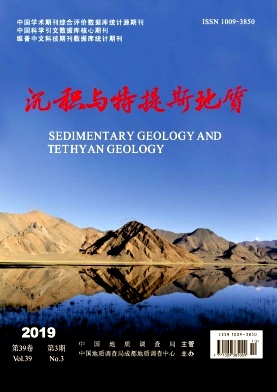|
[1]
|
Haq B U, Schutter S R. A chronology of Paleozoic sea-level changes[J]. Science, 2008, 322:64-68.
Google Scholar
|
|
[2]
|
Chen Z Q, George A D, Yang W R. Effects of Middle-Late Permian sea-level changes and mass extinction on the formation of the Tieqiao skeletal mound in the Laibin area, South China[J]. Australian Journal of Earth Sciences, 2009, 56:745-763.
Google Scholar
|
|
[3]
|
邱振,孙枢,王清晨,等. 瓜德鲁普统-乐平统全球界线层型剖面沉积相和层序地层[J]. 沉积学报,2014,32(3):429-441.
Google Scholar
|
|
[4]
|
Wignall P B, Sun Y D, Bond D P G, et al. Volcanism, Mass Extinction, and Carbon Isotope Fluctuations in the Middle Permian of China[J]. Science, 2009, 324:1179-1182.
Google Scholar
|
|
[5]
|
Jost A B, Mundil R, He B, et al. Constraining the cause of the end-Guadalupian extinction with coupled records of carbon and calcium isotopes[J]. Earth and Planetary Science Letters, 2014, 396:201-212.
Google Scholar
|
|
[6]
|
Clapham M E, Shen S Z, Bottjer D J. The double mass extinction revisited:reassessing the severity, selectivity, and causes of the end-Guadalupian biotic crisis (Late Permian)[J]. Paleobiology, 2009, 35:32-50.
Google Scholar
|
|
[7]
|
Flügel E, Wolfgang K. Patterns of Phanerozoic reef crises[C]. Tulsa:SEPM Special Publication, No. 72, 2002.691-733.
Google Scholar
|
|
[8]
|
Huang Y G, Chen Z Q, Zhao L S, et al. Restoration of reef ecosystems following the Guadalupian-Lopingian boundary mass extinction:Evidence from the Laibin area, South China[J]. Palaeogeography Palaeoclimatology Palaeoecology, 2019, 519:8-22.
Google Scholar
|
|
[9]
|
Shen S Z, Wang Y, Henderson C M, et al. Biostratigraphy and lithofacies of the Permian System in the Laibin-Heshan area of Guangxi, South China[J]. Palaeoworld, 2007, 16:120-139.
Google Scholar
|
|
[10]
|
Bond D P G, Hilton J, Wignall P B, et al. The Middle Permian (Capitanian) mass extinction on land and in the oceans[J]. Earth-Science Reviews, 2010, 102:100-116.
Google Scholar
|
|
[11]
|
Zhang G J, Zhang X L, Li D D, et al. Widespread shoaling of sulfidic waters linked to the end-Guadalupian (Permian) mass extinction[J]. Geology, 2015, 43:1091-1094.
Google Scholar
|
|
[12]
|
Wang X D, Sugiyama T. Middle Permian rugose corals from Laibin, Guangxi, South China[J]. Journal of Paleontology, 2001, 75:758-782.
Google Scholar
|
|
[13]
|
Huang Y G, Chen Z Q, Zhao L S. Biotic responses to volatile volcanism and environmental stresses over the GuadalupianLopingian (Permian) transition[J]. Geology, 2019, 47:175-178.
Google Scholar
|
|
[14]
|
Shen, S Z, Shi G R. Latest Guadalupian brachiopods from the Guadalupian/Lopingian boundary GSSP section at Penglaitan in Laibin, Guangxi, South China and implications for the timing of the pre-Lopingian crisis[J]. Palaeoworld, 2009, 18:152-161.
Google Scholar
|
|
[15]
|
Ehiro M, Shen S Z. Permian ammonoid Kufengoceras from the uppermost Maokou Formation (earliest Wuchiapingian) at Penglaitan, Laibin Area, Guangxi Autonomous Region, South China[J]. Paleontological Research, 2008, 12:255-259.
Google Scholar
|
|
[16]
|
Mei S L, Jin Y G, Wardlaw B R. Conodont succession of the Guadalupian-Lopingian boundary strata in Laibin of Guangxi, China and West Texas, USA[J]. Palaeoworld, 1998, 9:53-76.
Google Scholar
|
|
[17]
|
韦雪梅,江增光,白玛曲宗,韦恒叶. 广西来宾蓬莱滩剖面瓜德鲁普统-乐平统(G-L)界线生境型及其意义[J]. 东华理工大学学报(自然科学版),2016,39(4):331-340.
Google Scholar
|
|
[18]
|
Wang W, Cao CQ, Wang Y. The carbon isotope excursion on GSSP candidate section of Lopingian-Guadalupian boundary[J]. Earth and Planetary Science Letters, 2004, 220:57-67.
Google Scholar
|
|
[19]
|
Wei H Y, Wei X M, Qiu Z, et al. Redox conditions across the G-L boundary in South China:Evidence from pyrite morphology and sulfur isotopic compositions[J]. Chemical Geology, 2016, 440:1-14.
Google Scholar
|
|
[20]
|
王钦贤,童金南,宋海军,杨浩. 湖南慈利康家坪剖面二叠纪-三叠纪之交的生态系演变[J]. 中国科学(D辑:地球科学), 2009,39(9):1239-1247.
Google Scholar
|
|
[21]
|
Jin Y G, Shen S Z, Henderson C M, et al. The Global Stratotype Section and Point (GSSP) for the boundary between the Capitanian and Wuchiapingian stage (Permian)[J]. Episodes, 2006, 29:253-262.
Google Scholar
|
|
[22]
|
Qiu Z, Wang Q C, Zou C, et al. Transgressive-regressive sequences on the slope of an isolated carbonate platform (MiddleLate Permian, Laibin, South China)[J]. Facies, 2014, 60:327-345.
Google Scholar
|
|
[23]
|
陈军,徐义刚. 二叠纪大火成岩省的环境与生物效应:进展与前瞻[J]. 矿物岩石地球化学通报,2017,36:374-393.
Google Scholar
|
|
[24]
|
Zhang Z, Wang Y, Zheng Q F. Middle Permian smaller foraminifers from the Maokou Formation at the Tieqiao section, Guangxi, South China[J]. Palaeoworld, 2015, 24:263-276.
Google Scholar
|
|
[25]
|
Chen B, Joachimski MM, Sun Y D, et al. Carbon and conodont apatite oxygen isotope records of Guadalupian-Lopingian boundary sections:Climatic or sea-level signal[J]. Palaeogeography, Palaeoclimatology, Palaeoecology, 2011, 311:145-153.
Google Scholar
|






 DownLoad:
DownLoad: